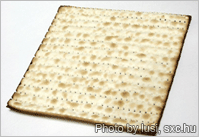Matzo (alternately spelled matza, matzah, matzoh, matze, or matsah) is a staple
of the Passover holiday. It is a type of unleavened flatbread that Jewish people
are instructed to eat from the first night of Passover throughout the following
week. Though it is a very simple food, made only of water and flour, matzo has a
complex history to it.
 Why Eat It?
Why Eat It?According to the story of Passover, once Moses
convinced the Egyptian Pharaoh to free the Hebrew slaves, the people were in
quite a rush to leave. In their haste, they neglected to allow their dough to
rise before baking it. Thus, matzo is eaten during Passover to commemorate the
plight of the Hebrew slaves. Matzo is also eaten as a lesson in humility. Since
it is often referred to as the "bread of affliction" matzo serves as a reminder
to appreciate one's freedom.
How Is It Made?Most bread
products contain water and flour, but, with matzo, those are the only
ingredients. The flour used to make matzo can be made of any of the following
grains: wheat, barley, spelt, rye, and oats, though wheat is most commonly used.
The water and flour are mixed together, and the dough is rolled into wide
sheets. Whether made by hand or by a machine, the dough is then perforated with
many holes, which will keep the matzo from puffing up as it cooks. After it is
baked, the matzo is put aside to cool. It is then packaged and shipped
throughout the world.
Did You Know?
It is said that the dough used to
make matzo will begin to leaven 18 minutes after first mixed. Therefore, the
dough has to be rolled out and put in the oven within that time
frame.
What Types of Matzo Are There?Most people are familiar
with those large, bumpy squares of matzo, but there are several other types. The
second most common type is called shmura matzo. This matzo is round and is made
by hand, rather than from a machine. Though matzo is traditionally made from
just flour and water, it can now come in a variety of flavors like poppy seed,
garlic, or the popular "everything" option. You could even find
chocolate-covered matzo or matzo made from organic flour.
 What Can You Do With It?
What Can You Do With It?For the week of
Passover, Jewish people aren't supposed to eat any products made from flour,
except for matzo. That means that they have to get creative with how it is used.
Matzo can be covered with butter for a simple snack or made into matzo pizza by
putting tomato sauce and mozzarella cheese on top. A more traditional way of
using matzo is to make matzo brei, which is matzo coated in egg and fried.
There are a few derivatives of matzo that are commonly used in Passover
cooking. For example, farfel is simply chunks of crushed up matzo, which can be
used similarly to pasta or stirred into soup. It can also be made into a hot
cereal, by softening it with warm water and mixing in milk and sugar. Matzo meal
is another derivative, which is a ground up version of matzo. This powder can be
used to make matzo balls (dumplings served in soup), thicken other dishes, or
create various desserts.
Though a humble piece of food, matzo has a long
and storied history. It initially gave sustenance to freed slaves on the run,
and it soon became a symbolic part of the Passover celebration. Today, matzo
comes in many varieties and has become quite a versatile cooking ingredient.